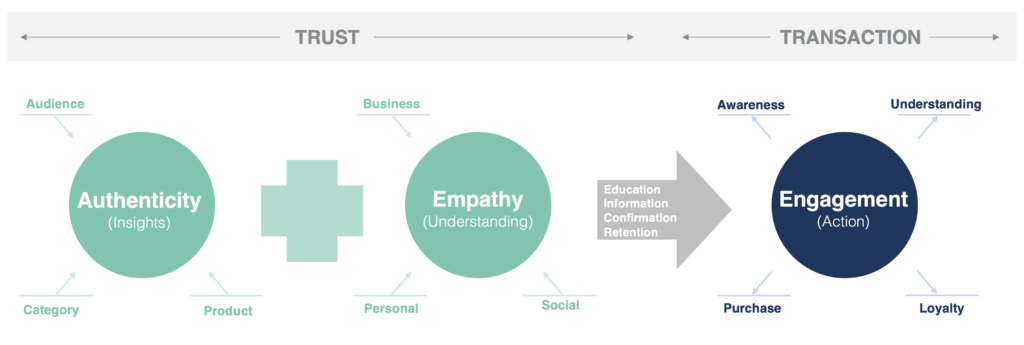When it comes to marketing your business, it’s important to consider all the different factors that can influence a customer’s purchase journey. Branding and demand generation are two critical marketing activities that play a significant role in this process:
- Branding helps establish a company’s reputation and differentiate it from its competitors. Strong branding can make a company more recognizable, trustworthy and memorable to potential customers, which can be crucial in attracting and retaining them.
- Demand generation, on the other hand, is the process of creating sustained interest in a company’s products or services through various marketing efforts. The goal of demand generation is to convert potential customers into leads and eventually into paying customers.
While branding and demand generation may seem like separate marketing activities, they work together to support the customer purchase journey in powerful ways.
By raising awareness of a company and its products or services, and by providing valuable information and resources that help potential customers make informed decisions, branding and demand generation play a critical role in influencing the purchase journey of potential customers and helping them move through the various stages of the sales funnel.
In this blog post, we’ll explore the importance of branding and demand generation in the customer purchase journey, and we’ll delve into the challenges and benefits of using these marketing activities together.
Branding
There are several elements that make up a brand, including the brand name, logo and brand identity. But further than these assets, Branding is the process of giving a distinct meaning and points of difference to a specific organization, products or services by creating and shaping the brand in consumers’/customers’ minds.
In addition to establishing a company’s reputation and differentiating it from its competitors, strong branding can also help businesses attract and retain customers. When customers are familiar with a brand and trust it, they are more likely to purchase from that company again in the future. This is especially important in today’s competitive business environment, where there are often many options available to consumers.
So, trust is a critical factor in generating demand and driving positive buyer action throughout the complex buyer journey. Trust is the foundation upon which all successful marketing campaigns are built, and it is created by delivering messaging that is both authentic and empathetic.
- Authenticity, the first key component to creating trust-building messaging, is based on insights regarding your audience, your category and your product’s unique value proposition (UVP). According to a 2021 study by Stackla, 90% of consumers say that authenticity is important when deciding which brands to support.
- Empathy, the second component, is based on a deep understanding of the ethnography of your audience’s business, personal life and social engagements. According to a 2021 study by Edelman, 65% of consumers say that a brand’s empathetic response to the pandemic has increased their loyalty.
Building trust through authenticity and empathy within your educational, informational, confirmational, and retention content can help move your buyer through the complex purchase journey and create engagement. Engagement is positive buyer action that can manifest as awareness, understanding, purchase, and loyalty. By creating messaging that is both authentic and empathetic, businesses can create a sense of trust that resonates with their buyers and drives positive buyer action.
- Engagement is the positive buyer action that can manifest as awareness, understanding, purchase, and loyalty. By creating messaging that is both authentic and empathetic, businesses can create a sense of trust that resonates with their buyers and drives positive buyer action.
Engagement and resulting purchase is the primary focus (and tracking metric) of the transaction stage of the buyer journey, in which the need for demand generation becomes readily apparent.

Demand Generation
The buyer journey is a multi-stage process that prospective buyers go through before making a purchase, including education, information, confirmation and retention. To effectively generate demand and drive positive buyer action throughout the journey, businesses need to deliver messaging that is tailored to the unique needs of buyers at each stage of the journey. Here’s how businesses can use different content themes to move a buyer through the complex journey:
- The education stage: Here, prospective buyers are in the early stages of the buying process and are seeking educational content to satisfy their needs. This stage is all about creating brand awareness and introducing prospective buyers to the business and its products or services. Businesses can use educational content to provide insights into the unique value proposition (UVP) of their products or services and establish credibility in the market. According to a 2021 study by Content Marketing Institute, 81% of businesses use educational content to generate demand.
- The information stage: Prospective buyers are now seeking informational content to satisfy their needs and move them towards a decision. This stage is all about providing information that is relevant to the buyer’s specific needs and interests. Businesses can use informational content to provide a deeper understanding of their products or services, differentiate themselves from competitors, and provide social proof through case studies and customer testimonials. According to a 2021 study by HubSpot, 47% of buyers view three to five pieces of content before engaging with a sales representative.
- The confirmation stage: This stage is all about providing the necessary information that will help the buyer make a decision and become a loyal customer. Businesses can use confirmational content to provide a final push towards a purchase and offer incentives, such as free trials or discounts, to encourage action. According to a 2021 study by Demand Gen Report, 90% of buyers say that they are more likely to make a purchase when a vendor provides content that is relevant to their needs.
- The retention stage: After an initial purchase, prospective buyers should be given content that builds long-term relationships, keeps them buying and grows share of wallet. Businesses can use retention content to provide ongoing value to the buyer, such as loyalty programs or exclusive content. According to a 2021 study by Emarsys, 80% of consumers are more likely to make a purchase from a brand that provides personalized experiences.
There are several tactics that businesses can use as part of their demand generation efforts, including lead generation, content marketing, social media marketing, email marketing and search engine optimization (SEO):
- Lead generation refers to the process of identifying and capturing the contact information of potential customers, typically using forms, landing pages or other lead capture tools. This information can then be used to nurture the lead and move them through education, to information, and then to confirmation and retention.
- Content marketing is the creation and distribution of valuable, relevant and consistent content to attract and retain a clearly defined audience. This can include blog posts, articles, infographics, videos and other types of content that are designed to provide value to the target audience and help them make informed decisions.
- Social media marketing is the use of social media platforms to reach and engage with potential customers. This can include creating social media profiles, posting updates and interacting with followers.
- Email marketing involves sending targeted, personalized emails to potential customers to nurture leads and drive conversions.
- SEO is the process of optimizing a website or online content in order to improve its ranking on search engines like Google. This can include optimizing website content, tags and meta descriptions as well as building backlinks to the site.
Ultimately, demand generation is a key marketing activity that helps businesses attract and convert potential customers into leads and paying customers. By using a variety of tactics, businesses can create a steady stream of leads and drive demand for their products or services.
Support demand with your brand, and vice versa
Combining branding and demand generation can be a powerful way to support the customer purchase journey. By establishing a strong brand identity and consistently conveying the brand message across all marketing channels, businesses can build trust and credibility with potential customers. This can be especially important when it comes to demand generation activities like content marketing, social media marketing and email marketing, where businesses are trying to engage with potential customers and provide them with valuable information.
However, using branding and demand generation together can also present some challenges for marketers, for instance, ensuring that a consistent brand message is conveyed across all marketing channels, and aligning demand generation efforts with branding goals.
Despite these challenges, a successfully executed campaign that strikes the right balance between brand and demand can pay dividends in capturing and retaining leads and sales generation.
By understanding how these marketing activities work together, businesses can develop effective marketing strategies that can help them attract and retain customers and drive demand for their products or services throughout the buyer journey.
Want to overcome your brand and demand challenges? We’re only a click or call away.




